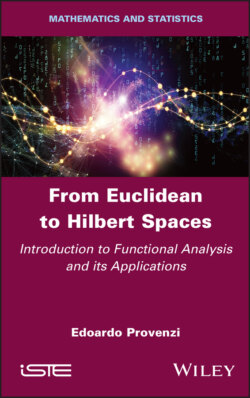Читать книгу From Euclidean to Hilbert Spaces - Edoardo Provenzi - Страница 15
NOTABLE EXAMPLES.–
ОглавлениеThree properties of the norm, which should already be known, are listed below. Taking any v, w ∈ V , and any α ∈ :
1) ‖v‖≽ 0, ‖v‖= 0 v = 0V ;
2) ‖αv‖= |α|‖v‖(homogeneity);
3) ‖v + w‖≼ ‖v‖+ ‖w‖(triangle inequality).
DEFINITION 1.4 (normed vector space).– A normed vector space is a pair (V, ‖ ‖) given by a vector space V and a function, called a norm, , satisfying the three properties listed above.
A norm ‖ ‖ is Hilbertian if there exists an inner product 〈 , 〉 on V such that .
Canonically, an inner product space is therefore a normed vector space. Counterexamples can be used to show that the reverse is not generally true.
Note that, by definition, 〈v, v〉 = ‖v‖ ‖v‖, but, in general, the magnitude of the inner product between two different vectors is dominated by the product of their norms. This is the result of the well-known inequality shown below.
THEOREM 1.3 (Cauchy-Schwarz inequality).– For all v, w ∈ (V, 〈 , 〉) we have:
PROOF.– Dozens of proofs of the Cauchy-Schwarz inequality have been produced. One of the most elegant proofs is shown below, followed by the simplest one:
– first proof: if w = 0V , then the inequality is verified trivially with 0 = 0. If w ≠ 0V , then we can define , i.e. and we note that:
thus:
as the two intermediate terms in the penultimate step are zero, since 〈z, w〉 = 〈w, z〉 = 0.
As ‖z‖2 ≽ 0, we have seen that:
i.e. |〈v, w〉|2 ≼ ‖v‖2‖w‖2, hence |〈v, w〉| ≼ ‖v‖‖w‖;
– second proof (in one line!): ∀t ∈ ℝ we have:
The Cauchy-Schwarz inequality allows the concept of the angle between two vectors to be generalized for abstract vector spaces. In fact, it implies the existence of a coefficient k between −1 and +1 such that 〈v, w〉 = ‖v‖‖w‖k, but, given that the restriction of cos to [0, π] creates a bijection with [−1, 1], this means that there is only one ϑ ∈ [0, π] such that 〈v, w〉 = ‖v‖‖w‖ cos ϑ. ϑ ∈ [0, π] is known as the angle between the two vectors v and w.
Another very important property of the norm is as follows.
THEOREM 1.4.– Let (V, ‖ ‖) be an arbitrary normed vector space and v, w ∈ V . We have:
[1.3]
PROOF.– On one side:
by the triangle inequality, thus ‖v‖ − ‖w‖ ≼ ‖v − w‖. On the other side:
thus ‖w‖ − ‖v‖ ≼ ‖v − w‖, i.e. ‖v‖ − ‖w‖ ≽ − ‖v − w‖.
Hence, −‖v − w‖ ≼ ‖v‖ − ‖w‖ ≼ ‖v − w‖, i.e. |‖v‖ − ‖w‖| ≼ ‖v − w‖.
The following formula is also extremely useful.
THEOREM 1.5 (Carnot’s theorem).– Taking v, w ∈ (V, 〈 , 〉):
and
PROOF.– Direct calculation:
If = , then , and since, if z = a + ib = ℜ (z) + iℑ(z), then z + = 2a = 2ℜ(z), we can rewrite [1.5] as:
The laws presented in this section have immediate consequences which will be highlighted in section 1.2.1.
